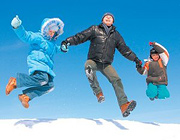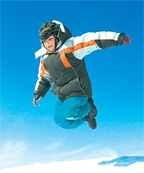Winter Warm Up
By Meghan Vivo
"It's too COLD.
I'll get SICK.
I might SLIP and FALL." All common excuses for avoiding exercise when the seasons change. With four to six months of winter in many parts of the country, you can't afford to skip winter exercise altogether. For both physical and mental well-being, the human body needs activity all year round. Whether you find creative ways to exercise indoors or dive into the great outdoors, maintaining an exercise regimen through the holidays and beyond will not only keep you fit, but also give you a head start come spring. Take It Outside If you don't want to stay cooped up inside for months, exercising outdoors can be a great way to stay in shape while appreciating the sights and sounds of winter. From snowball fights and sledding to snowshoeing and cross-country skiing, a host of outdoor activities await you. Of course, if you have any medical conditions or concerns about outdoor exercise, check with your doctor first. Here are a few tips to help make the most of your time outdoors: - Dress for the Cold. Layered clothing is essential when exercising in cold weather. The base layer should be a thin layer of synthetic material like polypropylene (such as Gore-Tex), which lets sweat evaporate away from your body. Next, wear a layer of fleece or similar material for insulation. The outer layer should be made of waterproof, wind-repellent, breathable fabric to let the heat out and keep the cold air from coming in. Since as much as 50 percent of heat loss comes from the head and neck, a hat and gloves are necessities. To warm the air before you breathe it, use a scarf or mask.
-
 Protect Your Skin. Winter weather brings cold, wind and humidity - all of which wreak havoc on your skin. The snow reflects the sun's rays, making sunburn possible even in the winter months. A basic regimen of sunscreen and moisturizer can protect your skin from harsh conditions.
Protect Your Skin. Winter weather brings cold, wind and humidity - all of which wreak havoc on your skin. The snow reflects the sun's rays, making sunburn possible even in the winter months. A basic regimen of sunscreen and moisturizer can protect your skin from harsh conditions. - Drink Fluids. When the air feels colder, you are less likely to realize you're thirsty. The drying effect of cold air actually increases the risk of dehydration, which in turn increases the risk of frostbite. So drink water before and after your workout, even if you don't feel thirsty.
- Beware of Wind Chill. The wind chill factor can be a serious problem for outdoor-fitness buffs. Start your workout into the wind and finish with it behind you (when you're sweaty) to avoid getting chilled. Fast motion such as skiing, running, cycling or skating can create wind chill because it increases the movement of air past your body. For example, if the temperature is 10 F and the air is calm, skiing at 20 miles per hour creates a wind chill of minus 9 F. If the temperature outside is well below zero or the wind chill is below minus 20, experts advise choosing an indoor activity instead.
- Dont't Push Your Luck. Sometimes you need to know when to get out of the cold. Exercising in the snow can be invigorating, but ice is treacherous and almost impossible to see, especially when it's on pavement. In icy conditions, move your favorite activities indoors. If you're out in severe conditions and notice you have a patch of hard, pale, cold skin, you may have frostbite. Slowly warm the affected area and seek emergency care if numbness continues. If you experience intense shivering, slurred speech, loss of coordination and fatigue, you may have hypothermia and should immediately seek emergency care.
Stay Indoors Despite all the excuses for not wanting to face the elements, there are times when it is wise to avoid outdoor activities. If you are too cozy in front of the fireplace to brave the outdoors, try one of these indoor workout options: - Walk the Mall. Although it takes some time getting to and from your local mall or shopping center, a few laps will get you moving while distracting you with shops and people-watching opportunities. Some malls even open their doors before operating hours solely for fitness walkers.
- Hit the Gym. Most health centers have dozens of weight machines, cardio equipment and fitness classes available to keep you motivated and energized to exercise throughout the winter. Choose a gym that is conveniently located and geared toward your fitness level. Most gyms provide a free initial consultation and session with a personal trainer to get you started, and some even offer special winter rates.
- Take a Dip. Gyms and local community centers often have pools available to the public. Water workouts are easy on the bones, joints and connective tissues, have a low risk of injury and offer excellent full-body benefits.
- No Need to Leave Home. If the weather makes it virtually impossible to get outside on a regular basis, create your own home gym to stay active. Buying used equipment or only the basics, like an exercise ball, dumbbells and resistance bands or a jump rope, can make this option affordable.
 Winter can be one of the most exhilarating times of the year. With the sun and snow and a variety of winter sports to choose from, there's no reason to hibernate indoors. It may be chilly and downright freezing at times, but your body still craves at least 30 minutes of exercise each day. Stay indoors if you have to, but if the conditions are decent and you dress appropriately, you still can walk, run, hike and play sports outside. Once you get going, you won't even notice the cold.
Winter can be one of the most exhilarating times of the year. With the sun and snow and a variety of winter sports to choose from, there's no reason to hibernate indoors. It may be chilly and downright freezing at times, but your body still craves at least 30 minutes of exercise each day. Stay indoors if you have to, but if the conditions are decent and you dress appropriately, you still can walk, run, hike and play sports outside. Once you get going, you won't even notice the cold. Winter Running Tips Revise Your Schedule
Only run half of your planned runs during bad winter weather. The other half of your time can be spent cross-training with indoor biking, weights or exercise videos until the weather lets up. Bring a Friend
Gather a group of friends to make your winter training more social. They'll not only motivate you to keep running in the winter cold, but you'll also have someone around to help if something goes wrong. Know How to Dress
Your choice of clothing color can make a big difference in how well others can see you. Wear light colors and reflective gear when it's dark outside, and bright colors when it's snowy. In general, runners should dress for weather that's 20 degrees warmer than it feels outside to prevent overheating after your body warms up. Sunglasses with polarized lenses are a must in the winter to block the glare from the snow, which can lead to snow blindness. Dry Off Quickly
If your jog ends at home, change into dry clothes as soon as you finish. If your jog ends elsewhere, be sure to bring a couple pairs of dry socks (at the least) to change into until you can get back home. Let Others Know Where You Are
Winter weather can be treacherous. Always let someone know where you will be and for how long. It is not a bad idea to take identification and a cell phone along, especially if you will be far away from home.
Page printed from:
http://www.toyourhealth.com/mpacms/tyh/article.php?id=980&no_paginate=true&no_b=true
|

